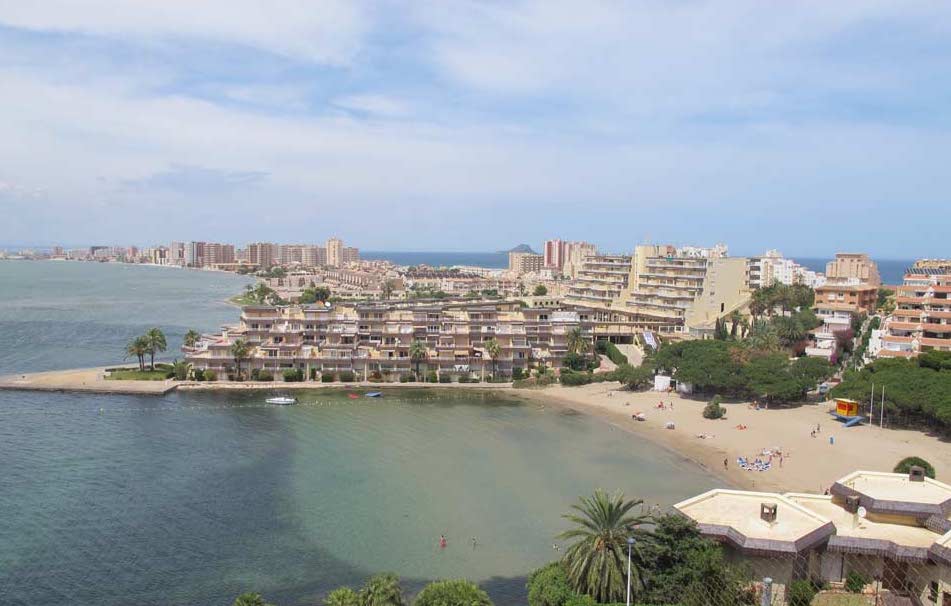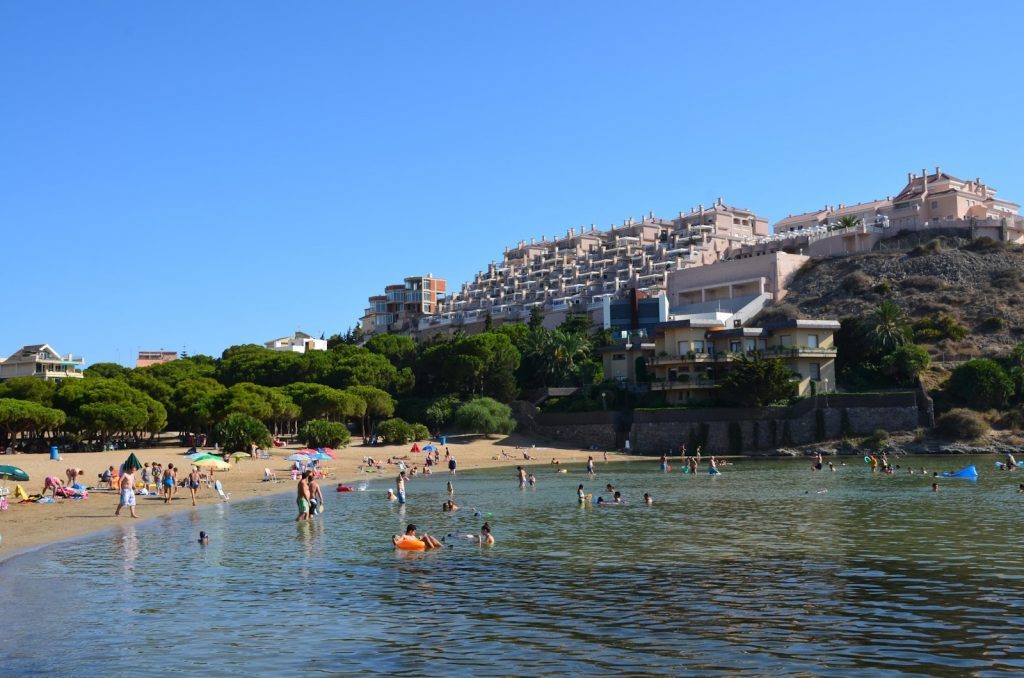The famous Spanish region of the Costa Cálida, is located on the Mediterranean coast of the province of Murcia and it is 250 kilometers long. Its administrative center is the city of Cartagena.
Where is the Costa Cálida in Spain located?
The northern border of the Costa Cálida is the Costa Blanca (Valencia), while the southern border is the Costa de Almería (Andalusia), so those who want to visit the Costa Cálida, can use one of their two airports: Alicante ( Alicante-Elche Airport) in the north; and San Javier (Murcia-San Javier Airport) in the south.
The Costa Cálida has a special and intact beauty. In the south you will find golden sand beaches and rocky shores, and in the north, an incredible natural wonder, the Mar Menor. The Mar Menor is a natural lagoon with a unique climate, separated from the Mediterranean Sea by a narrow tongue of land of 21 km in length: La Manga del Mar Menor.
The Costa Cálida of Spain on the map:
The Costa Cálida of Spain: weather
The climate of the Costa Cálida is very mild, pleasant and healthy, due to its privileged geographical location. The average air temperature in the summer months, is between +29 °C and +33 °C, and the water temperature is approximately +24 °C. While in winter the air heats up by an average between +14 °C and +18 °C. These pleasant temperatures are due to the mountains of the continent prevent the penetration of cold air masses in winter. The warm sea currents, the pure air, the gentle sea breeze and almost 320 sunny days per year, allow you to enjoy a wonderful holiday on the Costa Cálida throughout the year.

The Costa Cálida of Spain: characteristics
The Costa Cálida is a wonderful place full of multiple advantages, such as its unique and healthy microclimate; its wonderful beaches, many of which are awarded with the prestigious Blue Flag; its delicious cuisine, which offers traditional Mediterranean dishes, made with the best fresh products, such as seafood, vegetables and rice; a wide variety of tourist attractions: casinos, golf clubs, yacht clubs, diving and windsurfing schools; its ancient villages full of history, with Roman and Arabic era architecture; luxury hotels and cheap campsites; luxurious restaurants and small charming cafes; luxurious health resorts and spas: on the Costa Cálida, everyone will find something of their taste and budget.
Main cities of the Costa Cálida of Spain: real estate, attractions, beaches
Although near the Costa Cálida, there are such interesting cities, from a cultural and architectural point of view, such as Cartagena, Murcia and Lorca, the undoubtedly main advantage of this coast is its uniqueness, its healthy microclimate and its incredible beaches. Below, you will know in more detail several cities of the Costa Cálida, which are the most suitable for spending vacations and for permanent residence.
The Costa Cálida of Spain: La Manga del Mar Menor

La Manga del Mar Menor is a unique area of the Costa Cálida, to which beaches located in the Mediterranean Sea and the Mar Menor belong. Around 17,000 residents live permanently here (2015 data), however, in the summer season their number increases to 200,000.
Beaches. La Manga can boast of having golden beaches 40 kilometers long. Most of them have been awarded with the prestigious Blue Flag, because they are among the cleanest and most comfortable in the EU. In addition, they are very well equipped, near them there are walking trails and bicycle parking. Here you can find wide sandy beaches and picturesque rocky bays. La Manga residents and tourists can swim in two different seas on the same day: the Mediterranean and the Mar Menor, because they can pass from one to the other in 5-15 minutes! The water in the Mar Menor lagoon is always 2-4 degrees warmer than in the Mediterranean Sea. In addition, it has a unique healing composition, due to the mineral salts present in the water. Also, there are no heavy swells in the Mar Menor, so relaxing with young children is a real pleasure in this place. Among the best beaches are: Playa de Marchamalo, Playa Cala del Pino, Playa Cavanna, Playa Barco Perdido, Playa Galúa and many others. Given the considerable length of 40 kilometers of the beach line, some swimming areas do not even have a name, but that does not mean that swimming and sunbathing in them is not as good and safe as in urban beaches.

Attractions and entertainment. La Manga is ideal to spend the holidays at any time of the year, thanks to its wonderful temperate climate. Numerous tourists come here not only to entertain and relax, but also to recover. Warm sea water, with a rich mineral composition, has a beneficial effect on the entire body. It is beneficial for joint diseases and for dermatological and heart diseases. In addition, pure healing air is indicated for asthma, allergies and other respiratory diseases. Here you can undergo a treatment under the supervision of qualified specialists, or you can use the healing properties of black and blue mud baths, completely free of charge. The most popular leisure activities for tourists in La Manga are: exploring beaches, practicing water sports and excursions, visiting coffee shops and local restaurants, participating in sporting events, playing tennis, golf and bike touring.
Housing. According to data from the Idealista.com website, from October 2019, the average cost of residential housing in La Manga del Mar Menor, is € 1,526 / m2. The most expensive area is the Entremares area, with a cost of € 1612 / m2. Which is not surprising, after all, this area is between two seas, the Mediterranean and the Mar Menor, and it is therefore especially attractive to tourists. In the area of Playa de las Gaviotas-El Pedrucho, the cost of housing is also quite high, € 1535 / m2. The cheapest areas are: Playa del Galán (€ 1487 / m2) and Playa del Esparto-Veneziola (€ 1490 / m2). The cost of a studio here starts from € 35,000; of a duplex from € 76,500; of a small villa from € 69,500; and from a house from € 80,000.
La Manga del Mar Menor on the map:
The Costa Cálida of Spain: cities. Los Alcázares

Los Alcázares is a small, comfortable and welcoming tourist town on the Costa Cálida, located on the shores of the Mar Menor lagoon. Its population is 15,674 inhabitants (2018 census). The town attracts those who seek tranquillity and want to enjoy their holidays away from the tourist’s crowds. Los Alcázares is a town especially suitable for families with children and for the elderly. Also, it is suitable for those who wish to undergo a series of medical or cosmetic treatments, based on mud and mineral water from the Mar Menor.
Beaches. The coast of Los Alcázares, with fine golden sand, is located in the Mar Menor lagoon. Because the city is separated from the Mediterranean Sea by La Manga, the water here is very calm and warm; There is no strong swell and the coast area is quite wide. This area of the Costa Cálida has been chosen, for a long time, by families with children and the elderly. In addition, it is possible to bathe in the Mediterranean Sea: the water will be a couple of degrees colder, however, there is a wide range of water activities here: surfing, diving, fishing, etc.
These are the beaches that stand out the most: Paseo del Espejo, Las Palmeras, Paseo Carrión, Los Narejos, Paseo de Manzanares and others. All beaches are free and fully equipped: many of them have playgrounds for children and many bars, cafes and restaurants.

Attractions and entertainment. If the water activities of the coast of Los Alcázares bore you, you can go on a trip to Cartagena. This ancient city is located just 20 km from Los Alcázares, and it is famous for its ancient architecture, its shipyards and its maritime museums. Also, near Los Alcázares there are several natural reserves of volcanic origin, where you can enjoy the panoramic views of the surroundings from the crater of an extinct volcano. In addition, you can visit El Carmoli lake, which has a unique fauna and flora.
Housing. According to data from the Idealista.com website, from October 2019, the average cost of residential properties in Los Alcázares was € 1260 / m2. The most expensive area is Los Narejos-Punta Calera: the cost is € 1372 / m2. On the contrary, the most economical area is Las Lomas del Rame-Bahía Bella (€ 1130 / m2). The cost of an apartment starts from € 36,000, the cost of a duplex: from 66,100; the cost of a small chalet: from 40,100 €; and the cost of an independent house: from 57,000 €.
Los Alcázares on the map:
The Costa Cálida of Spain: cities. Lo Pagán

Lo Pagán is a small district and a popular area belonging to San Pedro del Pinatar. It is located in the north of the Mar Menor, on the same coast of the Costa Cálida. The population is 23,738 people (2019 census). Near Lo Pagán, you will find beautiful beaches, golf courses, rental bicycles, natural mud baths and salty lakes. The area is ideal for diving, surfing and fishing.
In the Lo Pagán market, you can always get fresh fish. In order to enjoy its ancient architecture, it is worth visiting the Count Villar de Felices’ palace and the Church of San Pedro Apóstol, located nearby, in San Pedro del Pinatar.
Beaches. The main beaches of Lo Pagán are: La Puntic Beach, La Mota Beach and Villananitos Beach, all located on the coast of the Mar Menor. In addition, near Villananitos, there is the protected area of Salinas and Arenales, with a unique fauna and flora.
 Attractions and entertainment. Most tourists come to Lo Pagán to visit the famous mud baths of Las Charcas. Such activities are completely free of charge, and anyone can benefit from its healing effects. Its effects are instantaneous and especially noticeable on the skin: it becomes unusually soft and silky. In addition, these muds are excellent for the treatment of arthritis and joints, whose results are significant after several procedures.
Attractions and entertainment. Most tourists come to Lo Pagán to visit the famous mud baths of Las Charcas. Such activities are completely free of charge, and anyone can benefit from its healing effects. Its effects are instantaneous and especially noticeable on the skin: it becomes unusually soft and silky. In addition, these muds are excellent for the treatment of arthritis and joints, whose results are significant after several procedures.
Housing. According to data from the Idealista.com website, from October 2019, the average cost of a residential property in Lo Pagán is € 1084 / m2. However, in the closest city to Lo Pagán, San Pedro del Pinatar, residential properties are somewhat more expensive: € 1101 / m2. The cost of an apartment in Lo Pagán starts from € 35,399; that of a duplex, from € 65,000; that of a small chalet, from € 42,000; and that of a detached house, from € 66,000.
Lo Pagán on the map:
Advantages of the Costa Cálida in order to live and to spend the holidays

The Costa Cálida region of Spain is being rapidly developed due to tourism. However, it is not yet as popular as, for example, the Costa Blanca. In this sense, it has its advantages:
- Peace of mind due to the absence of tourist´s crowds;
- Affordable housing offers for all tastes;
- Healthy microclimate;
- Wonderful natural landscapes;
- An ideal place to spend the holidays with the family, both with children and the elderly;
- Prohibition of density building by the authorities in order to preserve the environment of the area.
On the contrary, the inconveniences of the Costa Cálida, if there are any, may be attributed, perhaps, to the following:
- The lack of a vibrant nightlife: there are few bars and clubs that open until the wee hours;
- The tourism services sector has not yet developed as widely as in the most popular tourist areas of Spain.
On the other hand, the Costa Cálida offers excellent transport services: its comfortable buses, its high-speed trains and its two large airports on the Costa Cálida, make it possible to travel easily, safely and quickly, to other important cities in Spain. However, it is worth noting that, in Murcia and Cartagena, there is also much to see regarding architecture and history (shipyards, castles, maritime museums, etc.)
Therefore, the Costa Cálida is a very attractive place to live and invest nowadays. This region has very favourable prospects for the future.
You can find all our Costa Cálida housing offers, through our catalogue.



